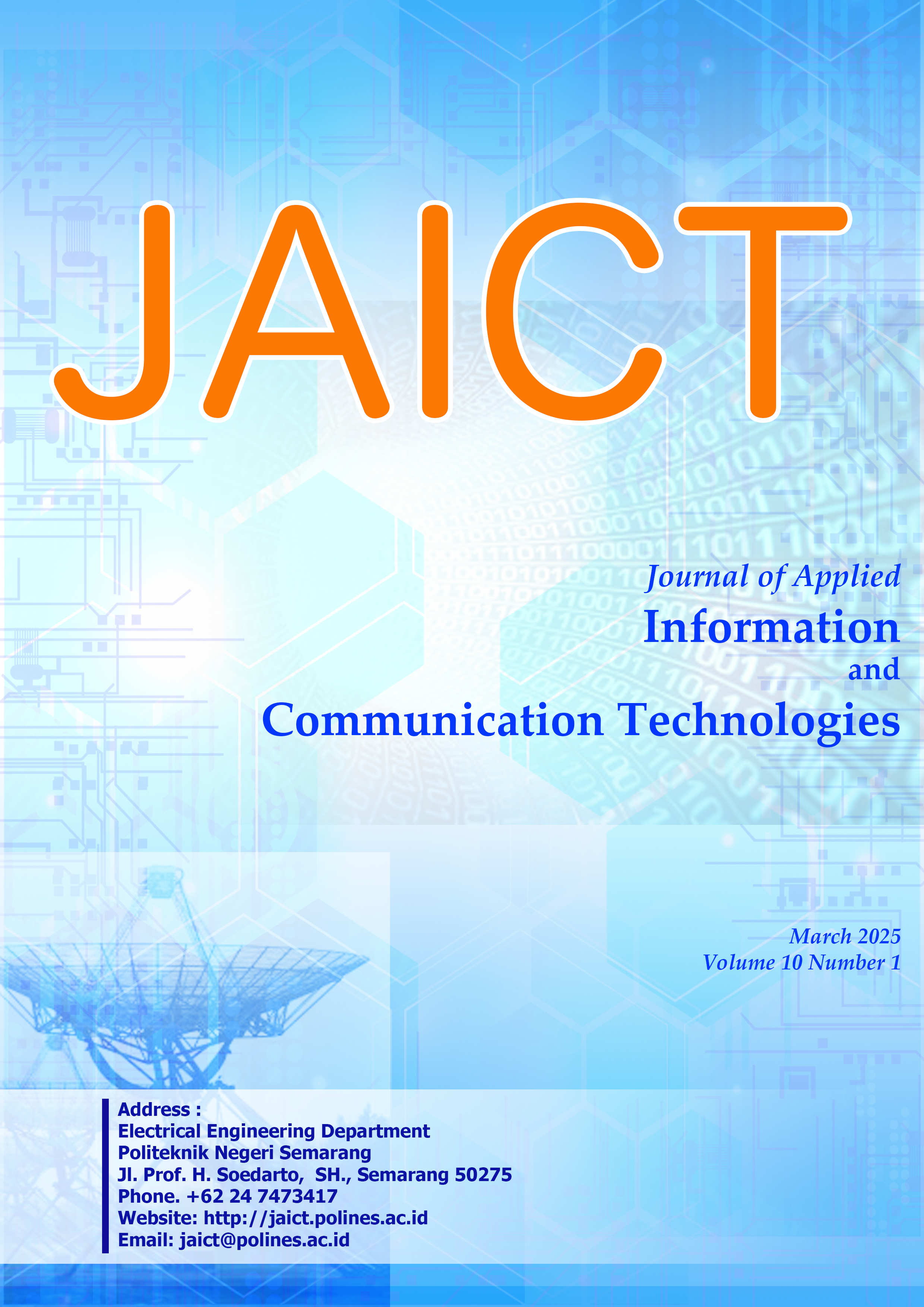Transcending Technologies : Probing Trends and Developments in Telecommunication Systems, Dense Wavelength Division Multipexing (DWDM) for Transmission and Configurafion ”“ A Comprehensive Review and Research Agenda
DOI:
https://doi.org/10.32497/jaict.v10i1.5409Keywords:
DWDM, Telecommunication System, Transmission System, Wireless TechnologyAbstract
Abstract - In recent years, telecommunication systems have developed so rapidly that it has created a technology trend for transmission and configuration systems. In terms of transmission and configuration, the main trend is to increase network capacity and speed, one of which is with wireless technology. Among the various wireless technologies available, with long-range communication capabilities, increased bandwidth, increased speed, network efficiency, and cost effectiveness, Dense Wavelength Division Multiplexing (DWDM) has emerged as the most popular choice for various applications in transmission systems and configurations. This literature review aims to provide a comprehensive overview of the latest telecommunication system trends and developments in DWDM technology by reviewing existing research and identifying key challenges and opportunities for the research agenda. This review will contribute to advancing knowledge in the field of telecommunication systems especially transmission and configuration to meet the demands of evolving technologies.
References
Apa Itu DWDM dan Keuntungannya Bagi Perusahaan? ”” Link Net. (n.d.). Apa Itu DWDM Dan Keuntungannya Bagi Perusahaan? ”” Link Net. https://www.linknet.id/article/apa-itu-dwdm-dan-keuntungannya-bagi-perusahaan
Team, I. (2022, August 11). Mengenal teknologi DWDM sebagai media penyaluran trafik komunikasi data kapasitas besar - INDONET. INDONET. https://indonet.co.id/mengenal-teknologi-dwdm-sebagai-media-penyaluran-trafik-komunikasi-data-kapasitas-besar/
Wardhani, T. a. H. (2022, January 15). Pengenalan Dasar Sistem Telekomunikasi - Griya Website dot com. Griya Website Dot Com. https://www.griyawebsite.com/pengenalan-dasar-sistem-telekomunikasi/
N., Kitsuwan., & K, Akaki. (2023). Performance of elastic optical network with limited slicers. ICT Express, 362-365
P, Eakkapan,, S, Somkuarnpanit., N, Pornsuwancharoen., & P, P. Yupapin. (2012). A new generate carrier for THz communication by the nonlinear microring resonator systems. Procedia Engineering, 468-474
S, Punthawanunta., P, P. Yupapin., X Louangvilayc., & S, Mitathad. (2011). Quantum CNOT Gate Operation using Dark-Bright Soliton Pair. Procedia Engineering, 445-450
H, Yu., P, Li., L, Zhang., Y, Zhu., F, A. Al-Zahrani., & K, Ahmed. (2020). Application of optical fiber nanotechnology in power communication transmission. Alexandria Engineering Journal, 5019-5030
N, Sangwaranatee., N, W. Sangwaranatee., C, Teeka., & P, P. Yupapin. (2012). All-Optical Nanoscale Microring Device and System Design for Nano Communication. Procedia Engineering, 509-515
M, S. Aziz., A, Afroozeh., M, S. Roslan., M, A. Jalil., I, N. Nawi., J, Ali., & P, P. Yupapin. (2011). Capacity Enhancement in Communication System via NNRR. Procedia Engineering, 407-411
M, J. Kappen., R, S. Asha., & T, Binesh. (2016). 10 Gbps externally modulated XGM based wavelength conversion using SOA. Procedia Technology, 25, 560-566
S, S. Kumar., S, Kalaivani., S, S. Ibrahim., & G, Swathi. (2023). Traffic and fragmentation aware algorithm for routing and spectrum assignment in Elastic Optical Network (EON). Optical Fiber Technology, 103480
R, Anthony., & S, Biswas. (2012). Temperature dependent gain analysis of a cascaded C-band EDFA DWDM network. Procedia Technology, 92-96
B, Sansoda., S, Thongmee., N, Pornsuwancharoen., P, P. Yupapin., & R, Phromloungsri. (2012). A New THz Frequency Band Generation for Optical radio System of RFID Applications. Procedia Engineering, 502-508
N, Pornsuwancharoen., K, Boonmeewised., N, Kitcharoen., B, Sansoda., P, P. Yupapin., & R, Phromloungsri. (2012). A novel optical radio on fiber multi-channel by micro ring resonator system. Procedia Engineering, 45-52
G, V. Arévalo., R, C. Hincapié., & R, Gaudino. (2017). Optimization of multiple PON deployment costs and comparison between GPON, XGPON, NGPON2 and UDWDM PON. Optical Switching and Networking, 80-90
L, Hou., & J, H. Marsh. (2016). Photonic integrated circuits based on quantum well intermixing techniques. Procedia Engineering, 107-114
J, Y. Wang., G, D. Song., X, H. Liu., C, Wang., & T, Y. Liu. (2011). A High Sensitive Micro-Seismic Fiber Bragg Grating (FBG) Sensor System. Procedia Engineering, 765-771
K, H. Koh., C, Leea., & T, Kobayashi. (2010). A 3-D MEMS VOA using translational attenuation mechanism based on piezoelectric PZT thin film actuators. Procedia Engineering, 613-616
A, Polar., M, Bunruangses., K, Luangxaysanam., S, Mitatha., & P, P. Yupapin. (2012). Overlay Fiber Network Based MNRs for P2P Networks. Procedia Engineering, 482-488
S, Chaiyasoonthorn., P, Youplao., S, Mitatha., & P, P. Yupapin. (2012). Privacy Amplification of QKD Protocol in a Quantum Router. Procedia Engineering, 536-543
G, C. Rodrigues., V, Vorkov., & J, R. Duflou. (2018). Optimal laser beam configurations for laser cutting of metal sheets. Procedia CIRP, 714-718
H, Zhou., S, Mao., & P, Agrawal. (2015). Optical power allocation for adaptive transmissions in wavelength-division multiplexing free space optical networks. Digital Communications and Networks, 171-180
D, Larrabeiti., L, M. Contreras., G, Otero., J, A. Hernández., & J, P. Fernandez-Palacios. (2023). Toward end-to-end latency management of 5G network slicing and fronthaul traffic. Optical Fiber Technology, 103220
W, Chong. (2011). A Depolarization Method to Seek The Suitable Refractive Index Value of The Middle Layer in Oblique Incidence. Procedia Engineering, 2170-2174
N. Sangwaranatee, N. W.Sangwaranatee, C. Teeka, P.P. Yupapin. (2012). All-Optical Nanoscale Microring Device and System Design for nano Communication. Procedia Engineering, 509-51
Downloads
Published
Issue
Section
License
Copyright (c) 2025 JAICT

This work is licensed under a Creative Commons Attribution 4.0 International License.
Authors who publish with this journal agree to the following terms:Authors retain copyright and grant the journal right of first publication with the work simultaneously licensed under a Creative Commons Attribution License that allows others to share the work with an acknowledgement of the work's authorship and initial publication in this journal.
Authors are able to enter into separate, additional contractual arrangements for the non-exclusive distribution of the journal's published version of the work (e.g., post it to an institutional repository or publish it in a book), with an acknowledgement of its initial publication in this journal.
Authors are permitted and encouraged to post their work online (e.g., in institutional repositories or on their website) prior to and during the submission process, as it can lead to productive exchanges, as well as earlier and greater citation of published work (See The Effect of Open Access).






